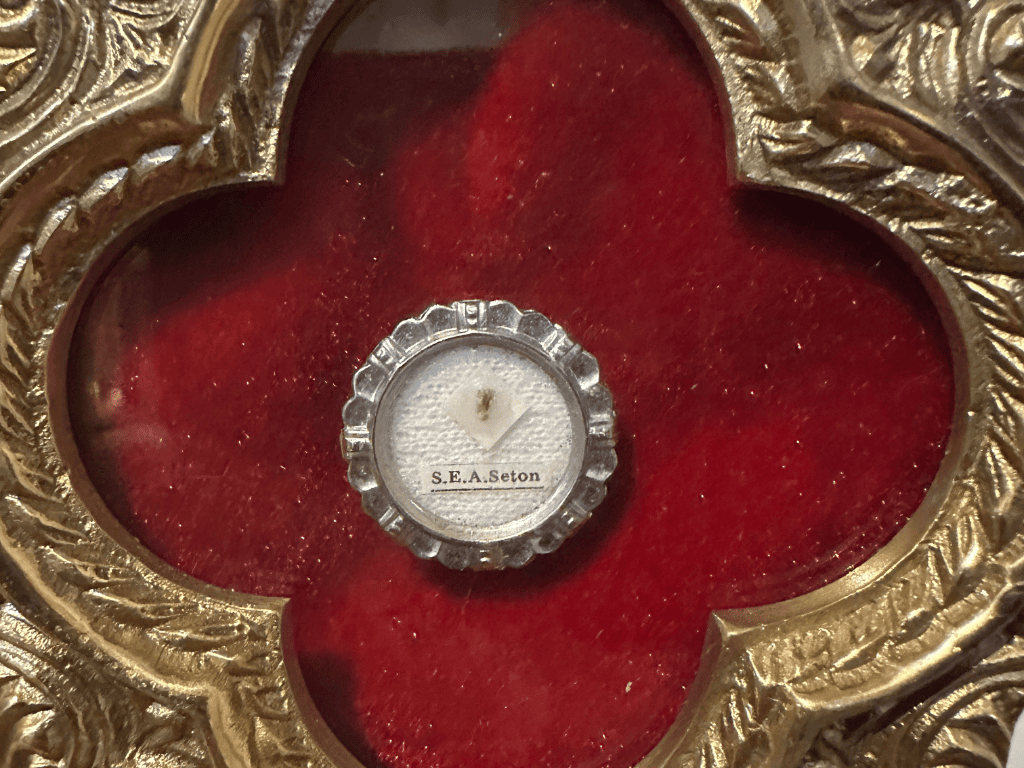Just a 10-minute walk around the interior of St. Mary’s Chapel at The Saint Paul Seminary can be transformative – especially if you know where to look.
Benjamin Peters does. As the seminary’s head sexton, the Diocese of Winona-Rochester seminarian is responsible for many of the physical items inside the chapel.
That includes six saintly relics and two more relics of the True Cross of Jesus Christ. Seminarians, deacon candidates, lay students, faculty, staff and guests are provided regular opportunities to venerate these small but profound remains of canonized heroes and the wood upon which their Savior died.
“The relics play an important role in our life here at the seminary, as they do for all Catholics, because they provide us an image of what we want to strive to be,” Peters said. “We all want to be saints, so when we have these relics present with us here in the seminary, they inspire us to live more holy lives.
“They inspire us to be better men, and eventually, someday, better priests.”
Anticipating transitional diaconate ordination this spring and priestly ordination a year later, Peters walks around the chapel and explains the seminary’s relics with all the reverence, fervor and polish of a seasoned tour guide. He starts with St. Teresa of Calcutta, who was friends with former seminary rector Monsignor Aloysius Callaghan; shortly after her canonization, the seminary received the relic that now sits in the back left corner of St. Mary’s Chapel.

Down the same side aisle, there’s a fragment from another one of Mother Teresa’s friends – a guy by the name of St. John Paul II. “JP2” and his influence are all over seminary formation, from his famous apostolic exhortation “Pastores Dabo Vobis” to his encouraging “be not afraid” mantra to young Catholics.
Together, St. Teresa of Calcutta and St. John Paul II inspired a generation of young Catholics – many of whom are now priests, deacons or lay leaders or preparing for these roles at The Saint Paul Seminary.
Seminarian Benjamin PetersThe relics play an important role in our life here at the seminary, as they do for all Catholics, because they provide us an image of what we want to strive to be. We all want to be saints, so when we have these relics present with us here in the seminary, they inspire us to live more holy lives.”
“It’s an inspiration for us to live a life without fear, fully trusting in the Lord our God, and then pursuing God with wild abandonment,” Peters said.
In between is a relic and statue of St. Elizabeth Ann Seton, the first canonized saint from the United States and the founder of the country’s private school system. A relic and accompanying statue of St. Padre Pio, the patron of adolescents and stress relief among other things, are in the front right corner – a short jaunt from those of St. John Neumann, an American saint like Seton who served as bishop of Philadelphia and founded the United States’ first diocesan Catholic school system.

To go back further in time, you have to follow Peters into the sacristy. This is where relics of St. Thomas Aquinas and St. John Vianney are kept between two different reliquaries containing shards of Christ’s cross.
Aquinas’ literature and wisdom are a key piece of seminary curricula. But this intellectual giant was once called a “dumb ox” by his classmates, which encourages seminarians and students in the face of challenge or scrutiny, Peters said.
And Vianney is the patron saint of parish priests. Some seminarians have visited his remains and shrine in Ars, France, the tiny backwater hamlet where Vianney grew into one of the most renowned priests in history.
But St. John Vianney and any of the other saints whose relics are present inside The Saint Paul Seminary chapel would tell you to bypass them and take a good, hard look at pieces of the True Cross.
“I don’t think I need to say much about why they’re so special to us,” Peters said.
Each relic comes with a certificate of authenticity verified and signed by a bishop, as well as his wax seal pressed inside the reliquary. The beams of the cross can be traced back to St. Helena, the mother of Constantine who discovered the cross during a pilgrimage to the Holy Land and brought the remaining boards back to Constantinople. The relics eventually were spread throughout Europe and later the United States — including St. Paul, Minnesota.
“They’re a reminder for how we, as men, are called to be priests, to sanctify the people who God has entrusted to our care,” Peters said. “It’s a blessing to have all of these relics … here with us in the seminary. We’re thankful for every moment that we get to spend with them and the way in which they inspire us to be good, happy, holy, healthy men and – hopefully someday – priests.”

Editor's Note: A version of this story originally ran on The Saint Paul Seminary website, which is located at the University of St. Thomas.






